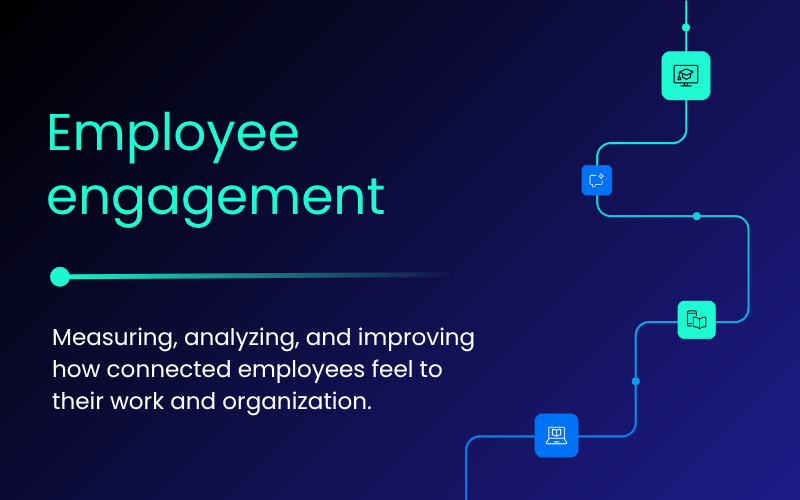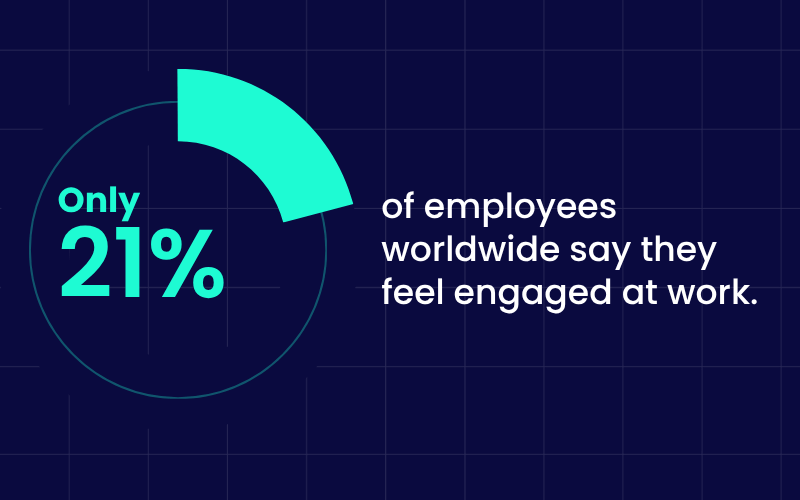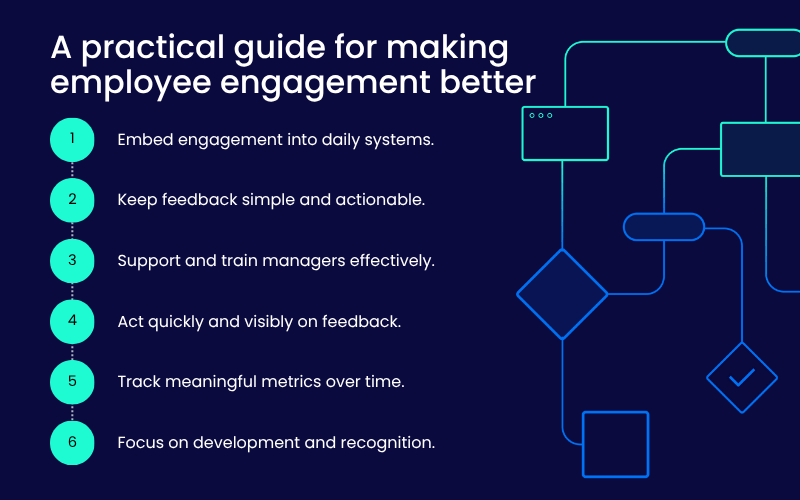Many employees show up to work feeling disconnected from their role, their team, and their organization’s mission. They complete their tasks but lack the enthusiasm and commitment that drives real performance. While some level of workplace stress and routine is inevitable, organizations can create systematic approaches to measure, understand, and improve how engaged their people truly feel.
The challenge is that most engagement efforts happen in isolation, annual surveys that disappear into email folders, feedback that never leads to action, and managers who lack the tools and training to make meaningful connections with their teams. When engagement becomes an afterthought rather than an ongoing priority, organizations miss out on one of their most powerful levers for performance and retention.
What are employee engagement workflows?

Employee engagement workflows are the systematic process of measuring, analyzing, and improving how connected employees feel to their work and organization. They typically include:
- Regular pulse surveys and NPS-style feedback collection
- Discussion forums and communication channels for employee voice
- Manager training and support tools for meaningful conversations
- Action planning and follow-up on engagement insights
While this sounds straightforward, effective engagement requires seamless integration into daily workflows rather than standalone activities. When engagement tools feel like extra work or live outside employees’ regular systems, participation drops and insights become less valuable.
The challenges
For most organizations, the biggest hurdle is the disconnect between engagement activities and daily work. Surveys and feedback tools often exist as separate systems that employees must remember to access, creating friction that reduces participation. Survey announcements get lost in crowded communication channels, and results often disappear without visible action.
Traditional engagement approaches compound the problem. Annual surveys provide outdated snapshots rather than real-time insights, managers lack training on how to act on feedback, and there’s often no clear process for turning insights into improvements. This creates a cycle where employees become skeptical of engagement efforts because they rarely see meaningful change.
It’s no surprise that only 21% of employees worldwide say they feel engaged at work, with disengagement costing the global economy $8.8 trillion annually in lost productivity. Without systematic approaches and manager support, organizations struggle to create the connection that drives performance.

The Solution: WalkMe
This is where digital adoption platforms like WalkMe become game-changers.
Rather than treating engagement as a separate activity, these platforms embed surveys, discussion spaces, and feedback tools directly into the systems employees use every day. WalkMe, specifically, offers contextual prompts for feedback, guided manager conversations, and real-time insights that make engagement a natural part of the workflow rather than an additional burden.
The results speak for themselves: companies using systematic engagement approaches often see 63-point improvements in engagement scores and 23% increases in profitability. But implementation success depends on following proven best practices.
A practical guide for making employee engagement better

- Embed engagement into daily systems
Engagement shouldn’t feel like extra work. Tools like WalkMe make it possible to integrate surveys, discussion spaces, and feedback opportunities directly into existing workflows, making participation natural and immediate rather than a separate task employees need to remember.
- Keep feedback simple and actionable
Short, focused surveys paired with benchmarking data provide clear insights without overwhelming employees. NPS-style questions can reveal engagement trends quickly, while targeted follow-ups help identify specific areas for improvement and track progress over time.
- Support and train managers effectively
Managers drive 70% of engagement outcomes, yet 44% receive no training. Digital guidance can provide coaching frameworks, conversation prompts, and tools that help managers build stronger connections with their teams and respond effectively to engagement challenges.
- Act quickly and visibly on feedback
Collecting feedback is only the first step—acting on it builds trust and demonstrates commitment. Whether addressing career development concerns, system frustrations, or culture issues, visible responses to employee input show that engagement efforts are genuine and impactful.
- Track meaningful metrics over time
Monitor participation rates, engagement scores, turnover patterns, and productivity indicators to understand what’s working. Use analytics to see how employees interact with engagement tools and adjust approaches when patterns suggest improvement opportunities.
- Focus on development and recognition
Career development and recognition are powerful engagement drivers, with 94% of employees staying longer when companies invest in their growth. Embedding development conversations and recognition opportunities into regular workflows strengthens connection and motivation.
Putting it all together
The combination of these strategies creates a comprehensive engagement ecosystem. When implemented effectively with platforms like WalkMe, HR teams can track engagement patterns, identify improvement opportunities, and create continuous feedback loops that strengthen organizational culture.
Although 58% of employees wish their company conducted engagement surveys more often, only 21% of companies run them three or more times per year. WalkMe bridges this gap by making frequent feedback collection seamless and ensuring engagement becomes an ongoing conversation rather than an annual event.
What success looks like
When employee engagement is done well, the benefits are clear:
- Higher engagement scores and increased survey participation rates
- Reduced turnover, especially in high-turnover roles and departments
- Improved team performance and stronger workplace culture
- Better manager effectiveness and employee satisfaction
Organizations that invest in systematic engagement see transformative results. Highly engaged teams are 23% more profitable and experience 59% less turnover in high-turnover environments, while manager engagement directly impacts team performance. With the right tools and processes, engagement becomes a competitive advantage that drives both employee satisfaction and business outcomes.

